St. John The Baptist Ukrainian Catholic Church in Newark NJ
Church Leaders
The Division of the Kyivan Metropolitanate
In 1620 Jerusalem Patriarch Theophanes III on his way back from Moscow, under the protection of the Kozaks, in particular Hetman Sahaidachny, secretly consecrated in Kyiv a new hierarchy, in particular Job Boretsky as metropolitan and bishops of all dioceses of the Church of Kyiv ruled by Uniate bishops. The secret consecration of a parallel hierarchy of the Kyivan Church was protested by the Polish government; however, the king did not join the conflict because he needed the help of the Kozaks. Even the Latin bishops were willing to sacrifice the Uniate metropolitanate for the good of the state’s interests to gain the support of the Kozaks.
In 1623 in Vitsebsk, the Uniate Archbishop of Polotsk Josaphat Kuntsevych was killed. The archbishop remains to this day the most controversial figure for the Ukrainian Greek Catholics and the Orthodox. For Greek Catholics he is holy; for the Orthodox he is an enemy of the Orthodox Church. Although the circumstances of his life and his murder have been heavily researched and are devoid of religious myths, they are known only by a narrow circle of scholars. Polemical assessments still dominate the church literature.
The murder of Archbishop Josaphat had quite a significant impact in both parts of the Kyivan Metropolitanate. His opponent for the Polotsk cathedra from the Orthodox side visited the Eastern Patriarchates. The decline, corruption and spread of heretical teachings of the Orthodox Church in the East asserted his belief about the appropriateness of the Kyivan Metropolitanate’s unity with the Roman Church. So after returning home, he transferred to the Uniate Metropolitanate. The conflicts of the 20s pushed both sides to seek understanding. The secular authorities also sought common ground. At this time there were several attempts to unify the two parts of the Metropolitanate of Kyiv, which, however, failed, on the one hand, because of the impossibility to reach an agreement with the Orthodox and, on the other hand, due to a different ecclesiological paradigm that prevailed in the Roman Church. Rome was opposed to representatives of the Uniate Metropolitanate taking part in the theological discussions with the Orthodox, leaving this prerogative to Ecumenical Council as well as referring to the decision of the Florence council, where all disputes were resolved. For these reasons in particular, a joint council did not take place in Lviv in 1629.
After the death of Job Boretsky in 1631, Isaiah Kopynsky led the Orthodox metropolitanate, followed by Metropolitan Petro Mohyla. And in 1632 the Polish diet adopted the Points of Reconciliation of the Subjects of the Crown and the Grand Duchy of Lithuania of the Ruthenian nation and Greek religion. In particular, the final division of the Kyivan Metropolitanate into the Uniate and Orthodox churches was recognized and each was guaranteed freedom of religion. The Orthodox received guarantees of their free existence and property assurance.
During the reigns of metropolitans Petro Mohyla and Rutsky there are more attempts to reach an agreement between the two parts of the Church of Kyiv. At that time appears the idea of an independent Kyivan Patriarchate, which would be equally independent of both Constantinople and Rome. This is evidenced in particular in Metropolitan Petro Mohyla’s memorial, which was sent to Rome, in which he formulates such an order for the Kyivan Church. Catholic ecclesiology at the time did not allow the model of unity proposed by Metropolitan Mohyla. Rome was not very supportive of the previous Uniate initiatives of Metropolitan Rutsky to establish a joint Kyivan Patriarchate to unite the divided Kyivan Metropolitanate.
After Bohdan Khmelnytsky’s uprising in 1648 and the treaty with Russia in Pereyaslav (1654), Ukrainian Orthodox Metropolitan Sylvester Kosiv found himself in a difficult situation. The senior management of the Orthodox metropolitanate and clergy, understanding the consequences of the union with Russia for the church, opposed the Church of Moscow. Kosiv’s successor, Lazarus Baranovych, was ordained back in Iasi, not in Moscow. And during the lifetime of Yurii Khmelnytsky new clauses provided by the Russian authorities stated that the Metropolitan of Kyiv shall be subject to the Patriarch of Moscow. So after political union, and in fact the occupation, Russia sought to extend its power over the Kyivan Metropolitanate. Moscow authorities in Kyiv did not allow metropolitans in the city, and appointed in Kyiv as locum tenens (place-holder) of the metropolitan throne. Several decades later in 1685 the Kyivan Orthodox metropolitanate was subordinated to the Moscow Patriarch by Metropolitan Gideon Chetvertynsky. Later, in 1686, for a reward the Patriarchate of Constantinople recognized the subordination.
Uniate Kyivan Metropolitanate in the Eighteenth and Nineteenth Century
The uprising led by Bohdan Khmelnytsky dealt a significant blow to the Kyivan Uniate Metropolitanate. On the one hand, many clergy members were killed, and all property was taken from the left-bank of the Dnipro River; on the other hand, these processes undermined any possibility of understanding in the future between the two parts of the former Kyivan Metropolitanate. The next calamity the Uniate Metropolitanate suffered when Russia’s troops entered Lithuanian lands during the reign of King Alexei Mikhailovich. Many Basilian monks and representatives of the white clergy were expelled or killed. Later the Lithuanian-Polish Commonwealth conquered some land in the Tsardom of Muscovy, but all the Uniate Metropolitanate’s cathedras could not be recovered.
In 1677 Lviv Bishop Joseph Shumlyansky secretly joined the union, and in 1679 the bishop of Przemysl Innocent Vinnitsa joined. In the dioceses of Lviv (1700), Przemysl (1693) and Lutsk (1702), the union was not adopted in haste, but for a long time the bishops explained to the clergy and nobility the need for such a step. After the transition of western dioceses into the union, Muscovy Tsar Peter I led his army into the Polish-Lithuanian Commonwealth to capture Metropolitan Lev Zalenskyj. On July 11, 1705, in the Polotsk monastery he slew six monks and hanged the hegumen. Peter was unable to capture the metropolitan, but Volyn Bishop Dionysius Zhabokyitsky was imprisoned and later died in prison. A few years after these events, those who remained faithful to the Orthodox Church in the commonwealth started to look at the union more favorably. And in 1708 the Lviv Stauropegion Brotherhood joined to the Uniate metropolitanate and in 1712 the Pochayiv monastery, and in 1721 the Krekhiv monastery.
During the reign of Metropolitan Lev Kiszka in 1720 a metropolitan council was held in Zamość. The council introduced a commemoration of the pope during the liturgy, decided to add the Filioque to the Creed, and forbade Orthodox from taking communion. The synod also introduced a number of Latin practices into the worship of the Uniate Metropolitanate, and drew special attention to the education of priests, particularly in the field of moral theology and catechism of the laity. Part of the reasoning was to strengthen the internal order of the metropolitanate. The resolutions of the Synod of Zamość, which was attended by the papal nuncio Jerome Grimaldi, were approved by the See of Rome in 1724 and officially published in Latin.
After Lev Kiszka, the metropolitan became Atanasii Sheptytsky, who introduced a series of internal reforms and established a new seminary. He was succeeded by Metropolitan Florian Hrebnicky.
In the middle of the eighteenth century the Russian Empire repeatedly tried to influence the religious policy of the Polish-Lithuanian Commonwealth in order to restore the Orthodox dioceses, and hence its influence on them. In 1760s with provocation from the Russian Empire the Koliyivshchyna rebellion broke out. Under the leadership of Maksym Zalizniak, a former lay brother at the Motronynsky Orthodox monastery, the rebels committed pogroms against Poles, Jews and Uniate clergy. The massacre in Uman was especially massive. The reasons for the uprising, in addition to provocation by Russia, were internal reasons, namely the disadvantaged situation of Ukrainians in the commonwealth compared to the Poles.
All of the Uniate priests in Right-bank Ukraine after the rebellion were replaced by Orthodox ones, and after the entry of the Russian troops (they entered the territory of the commonwealth to suppress the Haydamaky rebellion, since Catherine said she did not support Maksym Zalizniak’s uprising), Catherine ordered the all parishes to be transferred to the Orthodox Church and priests who refused to be arrested. In the Kyiv region alone 1,200 churches were taken. After the first partition of Poland (1772) in almost all regions (eastern Belarusian lands) that were part of the Russian Empire most Uniate parishes were forcibly transferred to the subordination of the Synod of St. Petersburg. A ban was placed on printing books. Only synod printing houses had the right to publish. Along with the parishes, monasteries were closed and Basilian monks were forbidden to preach. The church lost about 145 monasteries. In 1795 Catherine II abolished Uniate dioceses, and Metropolitan Theodor Rostotsky was sent to St. Petersburg (he could have chosen Rome, but wanted to be closer to the flock), where he died in 1805.
The life of the Uniate Kyivan Metropolitanate on the territory of the Russian Empire temporarily improved under the reign of Emperor Paul I, who opposed the forcible annexation of the Uniate parishes to Orthodoxy, and the Uniate Kyivan Metropolitanate was renewed. Many believers who were forcibly converted to the Orthodox Church returned to the Uniate Church. Three dioceses were restored within Russia: Polotsk, Lutsk and Brest. However, the next Russian emperor, Alexander I, tried to intervene in the Uniate Metropolitanate life as well as in the Roman Catholic Church. Specifically, in 1806 he appointed Irakly Lisovsky as metropolitan. (Management boards were established for the Catholics of both rites within the empire. A separate department for Latin and Eastern Rite existed.) But neither he nor his successor, Grygoriy Kokhanovych, were officially recognized by the Roman See (Lisovsky was regarded as the administrator of the metropolitanate). At the same time, the metropolitanate faced a threat of being converted to the Roman Church, which appealed to the Latin bishops. Due to the efforts Lisovsky and his successors, however, this was avoided. Lisovsky successively defended the autonomy of the Kyivan Metropolitanate, which at that time did not have sympathy in Rome.
Grygoriy Kokhanovych’s successor, Yosaf Bulgak, like his predecessors, was not recognized in Rome as the metropolitan. Bulgak was only an apostolic legate and was the last head of the Uniate Church in the Russian Empire. During his reign and with the assistance of the government he priest Iosif Semashko distanced himself from the Uniate clergy. He was one of the auditors of the Uniate board, which managed the metropolitanate, and members of which were loyal to the Russian authorities. In 1827, Semashko developed a plan to transfer the Uniate Metropolitanate into the Orthodox Church and submitted it for approval to Tsar Nicholas II, who, unlike his predecessors, did not tolerate the Uniates. The plan consisted in gradually adopting ritual practices of the metropolitanate to synodal standards as well as in reforming the metropolitanate administration. It was proposed to liquidate the metropolitanate and leave the two dioceses and concentrate their management in the hands of people faithful to the state. At the same time, Semashko zealously fought against the spread of the influence of the Basilian monasteries. In 1829 he was became bishop of Mstislav on the recommendation of the Holy Synod of the Russian Orthodox Church. In 1831 the Pochayiv monastery was taken from the Basilians, and in 1832 the novitiate was liquidated. In 1834, Anthony Zubko, a supporter of Semashko’s, was appointed to the Brest cathedra.
The methods developed by Semashko were not too successful, but after the death of Bulgak, who strongly opposed the move to the Orthodox Church, activists from the metropolitanate and the imperial state government took decisive action. Troops entered villages with the Uniate parishes, recalcitrant priests were deported to Siberia, and some joined the Orthodox Church. On February 12, 1839, in Polotsk three bishops – Semashko, Zubko, and Vasilii Luzhynsky – officially declared their transfer to the Russian Orthodox Church. All priests who did not agree were forbidden from practicing their ministry. Thus the Uniate Metropolitanate of the territory of Russia was entirely eliminated.
The Kholm diocese, which was in the Warsaw kingdom, was not abolished in 1839. After the Polish uprising, however, the Russian authorities took it upon themselves to eliminate the diocese. Pro-Russian priest Voynitsky was appointed to manage the diocese. He was not recognized by Rome, which instead appointed Mykailo Kuzemsky. The latter the Russian authorities arrested and sent to Galicia. He was replaced by a Russophile from Galicia, Markel Popel, who introduces the commemoration of the Holy Synod and rejects the commemoration of the bishop of Rome. In 1874 in the village of Pratulyn, the church community, which did not want to join the Orthodox Church, gathered before the church and tried to prevent the priest appointed by Popel from entering. In response, the military men who came to the village opened fire killing 13 and wounding 180; and 580 people were taken to Siberia. All who died were canonized by the Catholic Church as martyrs on October 6, 1996.
But eventually signatures were collected for the transfer of the Kholm diocese to the Russian Orthodox Church. The formal accession took place on May 11, 1875. Two hundred Galician Russophiles replaced the dissenting priests.
Uniate Kyivan Metropolitanate from the Twentieth Century to the present
Metropolitan Andrey Sheptytsky (1901-1944)
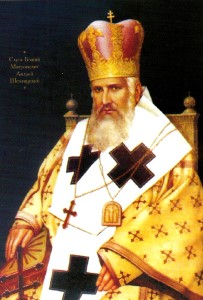
Metropolitan Andrey Sheptytsky (1901-1944)
During his 44-year tenure, he guided the Church and Ukrainian society through two world wars and seven changes of regime: Austrian, Russian,Ukrainian, Polish, Soviet, Nazi and Soviet. He was born in Prylbychi, near Lviv, on 22 July 1865 to an ancient aristocratic Ukrainian family which in the nineteenth century had become polonized, Latin Catholic and French speaking. Despite the strong opposition of his father, he returned to his roots to serve what was regarded as the peasant Ukrainian Greek Catholic Church as a monk of the Basilian Order.
Blessed with extraordinary spiritual charisms, at the age of thirty-six Sheptytsky became head of the Ukrainian Greek Catholic Church. He worked tirelessly for reconciliation between ethnic groups and left a rich legacy of writings on social issues and spirituality. He developed modern methods of ministry, founded the Studite and Ukrainian Redemptorist orders, other religious communities, a hospital, the national Museum, the Theological Academy and sponsored various religious, cultural and educational institutions.
Sheptytsky was a patron of artists, students, including many Orthodox Christians, and a pioneer of ecumenism. He learned Hebrew so that he could speak with Jews. During pastoral visits to towns he was met by Jewish communities with the Torah. He harbored hundreds of Jews in his residence and in Greek Catholic monasteries during the Nazi occupation. He issued the pastoral letter, "Thou Shalt Not Kill," a bold outcry against Nazi atrocities. He died on 1 November 1944 and the process for his beatification is well advanced.
Josyf Slipiy, Major Archbishop, Patriarch, Cardinal (1944-1984)

Josyf Slipiy, Major Archbishop, Patriarch, Cardinal (1944-1984)
Born in Zazdrist in western Ukraine on 17 February 1892, he was a churchman of three careers: scholar, confessor of the faith and an international voice for persecuted Christians. After studies in Lviv, Innsbruck (Austria), Rome and Paris, he became a professor and then Rector (1928-44) of the Lviv Seminary and Theological Academy. A prolific writer, his collected works include some twenty volumes. In 1939 he was ordained archbishop by Metropolitan Sheptytsky and succeeded him as head of the Ukrainian Greek Catholic Church upon the latter's death on 1 November 1944.
On 11 April 11 1945 Slipiy was arrested by the Soviet authorities and spent eighteen years in Stalinist prisons, labor camps and Siberian exile, where he earned a reputation for being an iron-willed, intrepid witness to the faith. Through the intervention of Pope John XXIII and President Kennedy he was released in 1963 to attend the Second Vatican Council.
During the following twenty-one years Slipiy energized the life of the Ukrainian Greek Catholic Church in the West, establishing the Ukrainian Catholic University and building the Cathedral of St. Sophia in Rome. His death on 7 September 1984 was followed in 1992 by the translation of his remains to Lviv, where they were interred in St. George's Cathedral with the participation of over a million faithful.
Archbishop Volodymyr Sterniuk, locum tenens (acting head) of the Ukrainian Greek Catholic Church in Ukraine (1972-1991)
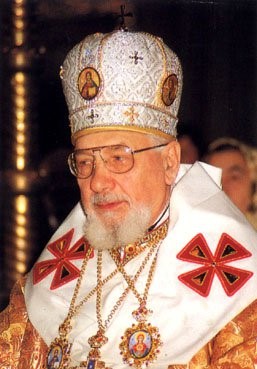
Archbishop Volodymyr Sterniuk, locum tenens (acting head) of the Ukrainian Greek Catholic Church in Ukraine (1972-1991)
Born on 12 February 1907 at Pustomyty near Lviv,after studies in Ukraine and Belgium he was ordained in 1931 as a priest of the Redemptorist order. He witnessed the liquidation of the Ukrainian Greek Catholic Church at the "synod" of Lviv by concealing himself in the loft of St. George's Cathedral.
After his arrest in 1947, he spent five years in prison and labor camps in Siberia. He returned to Lviv to work as a park gatekeeper, bookkeeper, janitor and ambulance nurse while clandestinely continuing his priestly ministry.
In 1964 Sterniuk was secretly ordained bishop and from 1972 to 1991 guided the UGCC in Ukraine until the return ofCardinal Lubachivsky. This period included the vicious persecution of the Brezhnev years and the final struggle for liberation in the late 1980s.
As a charismatic pastor and leader of the underground church, Sterniuk guided it from a one-room communal flat with a kitchen and bathroom shared with neighbors. He is remembered for his combination of prudence, resoluteness, warmth and understanding. He died on 29 September 1997 and a great funeral procession was conducted through the center of Lviv.
Myroslav Ivan Lubachivsky, Major Archbishop and Cardinal (1984-2000)
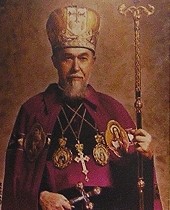
Myroslav Ivan Lubachivsky, Major Archbishop and Cardinal (1984-2000)
Born and raised in western Ukraine, he studied for three years in Lviv at the Greek-Catholic Theological Academy, predecessor of the present-day Lviv Theological Academy. Sent abroad to study, he could not return to his homeland for decades, because of the Soviet occupation. He served the Ukrainian diaspora in the United States, was elected Ukrainian Archbishop of Philadelphia in 1979 and in 1984 became Major Archbishop of the Ukrainian Catholic Church.
Following his return to Lviv on 30 March 1991, Lubachivsky led the renewal of the Ukrainian Greek Catholic Church in Ukraine. Throughout a five-year period, as pastor to 7 million faithful, he found himself in a challenging position. The spiritual revitalization of a devastated Church, alleviating tensions with the Orthodox, rebuilding various church institutions, answering the needs of his clergy, building bridges with government officials and adhering to the expectations of lay activists, all posed a formidable task for Lubachivsky on a daily basis.
In 1995 Lubachivsky suffered a bout of pneumonia, which took a toll on his health. The following year, due to his frail condition, the Synod of Ukrainian Catholic Bishops chose Bishop Lubomyr Husar as Auxiliary-Bishop to the head of the Ukrainian Catholic Church. After Cardinal Lubachivky's death on December 14, 2000 thousands of faithful braved freezing temperatures to pay their last respects.
Lubomyr Husar, Major Archbishop, Patriarch and Cardinal (2001-2011)
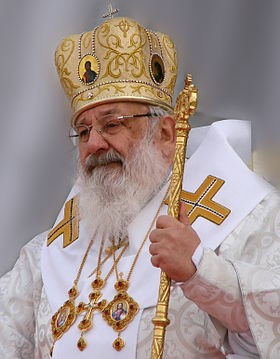
Lubomyr Husar, Major Archbishop, Patriarch and Cardinal (2001-2011)
Born in Lviv on 26 February 1933, he emigrated with his family in 1944, ending up in the United States. In 1958 he was ordained to the priesthood there and in 1972 he went to Rome and joined the Studite Order. In 1977 Cardinal Slipiyconsecrated him bishop for the Church in Ukraine.
Husar resided at the Studite Monastery in Grottaferrata, Rome until 1992, when he returned to live in Ukraine. On 17 October 1996 he was appointed Auxiliary-Bishop to Cardinal Lubachivsky. After Lubachivski's death, the Synod of Bishops elected him the next Major Archbishop. He was enthroned on January 28, 2001 and on the same day it was announced that Pope John Paul II had named him cardinal.
Sviatoslav Shevchuk, Major Archbishop, Patriarch (25 March 2011-present)
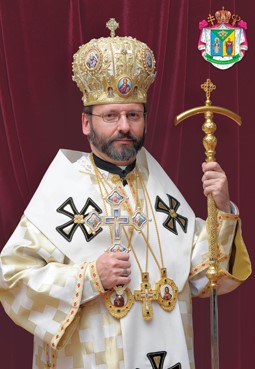
Sviatoslav Shevchuk, Major Archbishop, Patriarch (25 March 2011-present)
Born on May 5, 1970, in Stryi, Lviv region.
Education:
- 1991-1992 - Center for Philosophy and theological studies "Don Bosco" in Buenos Aires, Argentina
- 1992-1994 - Lviv Theological Seminary
- 1994-1995 - Pontifical University of Thomas Aquinas (Rome, Italy). BA in Theology
- 1995-1997 - Pontifical University of Thomas Aquinas. Theological Faculty, Section of moral theology
- 1997-1999 - Pontifical University of Thomas Aquinas. Doctorate with Summa cum laude in theological anthropology and moral theology.
Pastoral activity:
- 1999-2000 - Prefect of the Lviv Holy Spirit Theological Seminary
- 2000-2007 - vice rector of Lviv Holy Spirit Theological Seminary
- Since 2001 - vice dean of Theology Faculty of the Lviv Theological Academy (today known as the Ukrainian Catholic University)
- 2002-2005 - Head of Secretariat and personal secretary to His Eminence Lubomyr, head of the Patriarchal Curia in Lviv
- From June 2007 - rector of the Lviv Holy Spirit Theological Seminary.